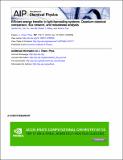Efficient energy transfer in light-harvesting systems: Quantum-classical comparison, flux network, and robustness analysis
Author(s)
Wu, Jianlan; Liu, Fan; Ma, Jian; Silbey, Robert J.; Cao, Jianshu
DownloadCao_Efficient energy transfer.pdf (1.206Mb)
PUBLISHER_POLICY
Publisher Policy
Article is made available in accordance with the publisher's policy and may be subject to US copyright law. Please refer to the publisher's site for terms of use.
Terms of use
Metadata
Show full item recordAbstract
Following the calculation of optimal energy transfer in thermal environment in our first paper [J. L. Wu, F. Liu, Y. Shen, J. S. Cao, and R. J. Silbey, New J. Phys.12, 105012 (2010)], full quantum dynamics and leading-order “classical” hopping kinetics are compared in the seven-site Fenna-Matthews-Olson (FMO) protein complex. The difference between these two dynamic descriptions is due to higher-order quantum corrections. Two thermal bath models, classical white noise (the Haken-Strobl-Reineker (HSR) model) and quantum Debye model, are considered. In the seven-site FMO model, we observe that higher-order corrections lead to negligible changes in the trapping time or in energy transfer efficiency around the optimal and physiological conditions (2% in the HSR model and 0.1% in the quantum Debye model for the initial site at BChl 1). However, using the concept of integrated flux, we can identify significant differences in branching probabilities of the energy transfer network between hopping kinetics and quantum dynamics (26% in the HSR model and 32% in the quantum Debye model for the initial site at BChl 1). This observation indicates that the quantum coherence can significantly change the distribution of energy transfer pathways in the flux network with the efficiency nearly the same. The quantum-classical comparison of the average trapping time with the removal of the bottleneck site, BChl 4, demonstrates the robustness of the efficient energy transfer by the mechanism of multi-site quantum coherence. To reconcile with the latest eight-site FMO model which is also investigated in the third paper [J. Moix, J. L. Wu, P. F. Huo, D. F. Coker, and J. S. Cao, J. Phys. Chem. Lett.2, 3045 (2011)], the quantum-classical comparison with the flux network analysis is summarized in Appendix C . The eight-site FMO model yields similar trapping time and network structure as the seven-site FMO model but leads to a more disperse distribution of energy transfer pathways.
Date issued
2012-11Department
Massachusetts Institute of Technology. Department of ChemistryJournal
The Journal of Chemical Physics
Publisher
American Institute of Physics (AIP)
Citation
Wu, Jianlan, Fan Liu, Jian Ma, Robert J. Silbey, and Jianshu Cao. “Efficient energy transfer in light-harvesting systems: Quantum-classical comparison, flux network, and robustness analysis.” The Journal of Chemical Physics 137, no. 17 (2012): 174111. © 2012 American Institute of Physics
Version: Final published version
ISSN
00219606
1089-7690